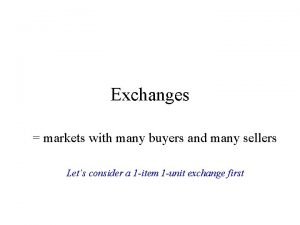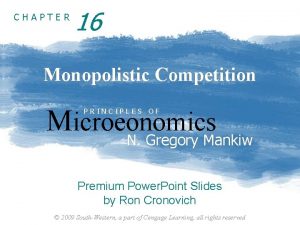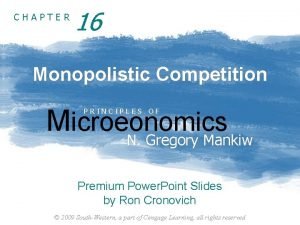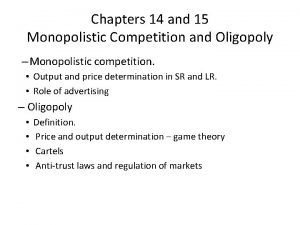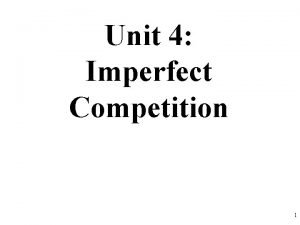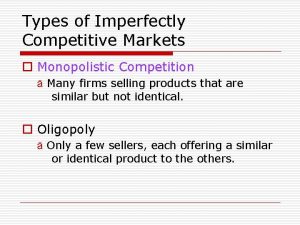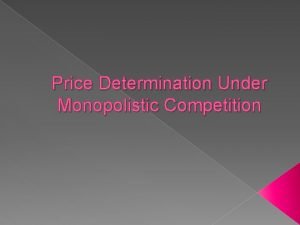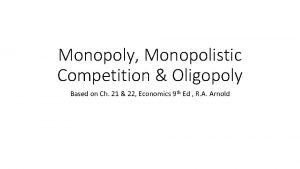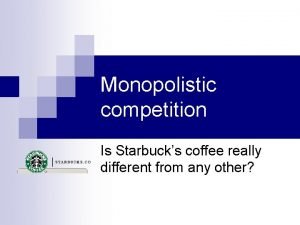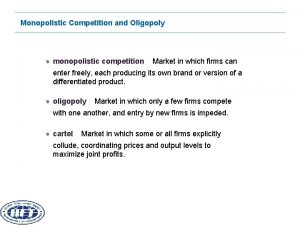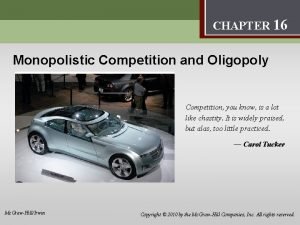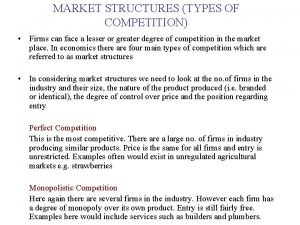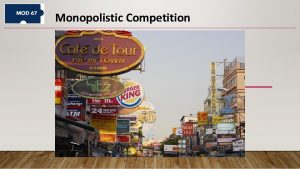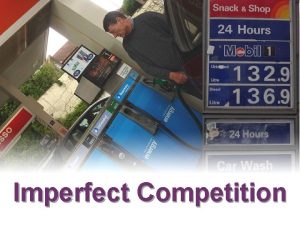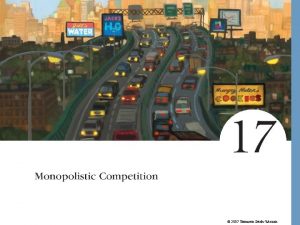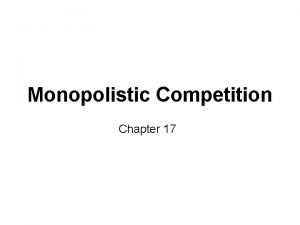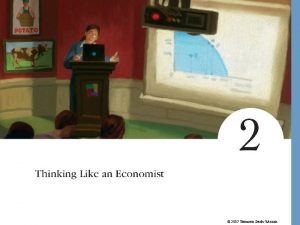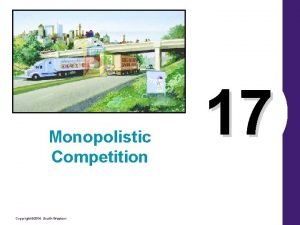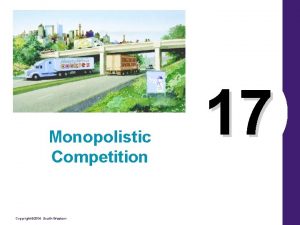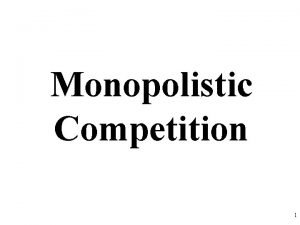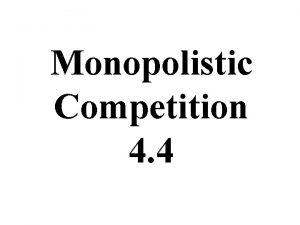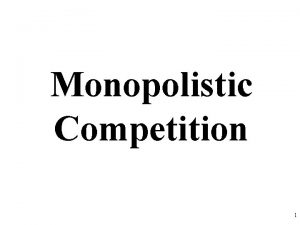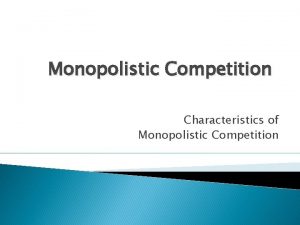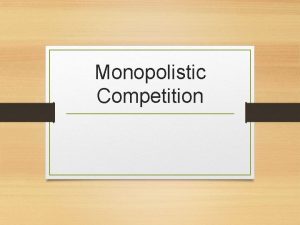2007 Thomson SouthWestern Monopolistic Competition Characteristics Many sellers




















- Slides: 20

© 2007 Thomson South-Western

Monopolistic Competition • Characteristics: – Many sellers – Product differentiation – Free entry and exit – In the long run, profits are driven to zero Firms have some control over price © 2007 Thomson South-Western

What does the costs graph for one of these firms look like? © 2007 Thomson South-Western

3

Short-Run vs. Long Run • Like competitive firms, the market adjusts in the short run until zero profits are earned in the long run © 2007 Thomson South-Western

The Monopolistically Competitive Firm in the Short Run • Two things can happen • A firm could experience economic loss • A firm could experience economic profit © 2007 Thomson South-Western

What if a firm is earning profit? © 2007 Thomson South-Western

Figure 1 Monopolistic Competition in the Short Run (a) Firm Makes Profit Price MC ATC Price Average total cost Demand Profit MR 0 Profitmaximizing quantity Quantity © 2007 Thomson South-Western

Short Run Profits • Encourage new firms to enter the market. This: – Increases the number of products offered. – Reduces demand faced by firms already in the market. • Demand curves shift to the left. • Profits decline. © 2007 Thomson South-Western

Figure 2 A Monopolistic Competitor in the Long Run Price MC ATC When profit is earned, firms will enter the market until profit is driven to zero P = ATC Demand MR 0 Profit-maximizing quantity And this tangency lies vertically above the intersection of MR and MC. Quantity © 2007 Thomson South-Western

What if a firm has short run losses? • Firms long run response will be to exit the market • Decreases the number of products offered. • Increases demand faced by the remaining firms until profit is driven to zero © 2007 Thomson South-Western

Figure 1 Monopolistic Competitors in the Short Run (b) Firm Makes Losses Price MC ATC Losses Average total cost Price MR 0 Lossminimizing quantity Demand Quantity © 2007 Thomson South-Western

In the long run, firms will continue to enter and/or exit the market until a firm’s economic profit is driven to zero… © 2007 Thomson South-Western

The Long-Run Equilibrium • Two Characteristics • As in a monopoly, price exceeds marginal cost. • Causes deadweight loss • As in a competitive market, price equals average total cost. • Free entry and exit drive economic profit to zero. © 2007 Thomson South-Western

Monopolistic versus Perfect Competition • There is a noteworthy difference between monopolistic and perfect competition: • Excess capacity • The actual capacity (production) by a firm is less than what is optimum for the firm • Optimum production (efficient scale) is where MC = ATC © 2007 Thomson South-Western

Figure 3 Monopolistic versus Perfect Competition (a) Monopolistically Competitive Firm Price MC MC ATC P P = MC MR 0 (b) Perfectly Competitive Firm Quantity produced Efficient scale ATC P = MR (demand curve) Demand Quantity 0 Quantity produced = Efficient scale Quantity Excess capacity © 2007 Thomson South-Western

Monopolistic versus Perfect Competition • Excess Capacity • There is no excess capacity in perfect competition in the long run. • There is excess capacity in monopolistic competition in the long run. • In monopolistic competition, output is less than the efficient scale. © 2007 Thomson South-Western

Monopolistic Competition and the Welfare of Society • There is the normal deadweight loss of monopoly pricing in monopolistic competition caused by the markup of price over marginal cost. © 2007 Thomson South-Western

Deadweight Loss Price MC ATC P = ATC MR 0 Monopoly quantity Market efficient quantity Demand Quantity © 2007 Thomson South-Western

ADVERTISING • When firms sell differentiated products and charge prices above marginal cost, each firm has an incentive to advertise in order to attract more buyers to its particular product. • The firm is trying to shift their demand curve to the right to make more short-run profits. © 2007 Thomson South-Western
 Monopoly characteristics
Monopoly characteristics Monopoly vs monopolistic competition
Monopoly vs monopolistic competition Monopoly vs oligopoly venn diagram
Monopoly vs oligopoly venn diagram Perfect competition vs monopolistic competition
Perfect competition vs monopolistic competition Perfect competition 4 conditions
Perfect competition 4 conditions Many sellers and many buyers
Many sellers and many buyers Thomson southwestern
Thomson southwestern Monopolistic competition example
Monopolistic competition example Monopolistic competition characteristics
Monopolistic competition characteristics Conclusion of monopolistic competition
Conclusion of monopolistic competition Barriers of entry for oligopoly
Barriers of entry for oligopoly Characteristics of monopoly
Characteristics of monopoly Excess capacity
Excess capacity Price output determination under monopolistic competition
Price output determination under monopolistic competition Consumer surplus in monopolistic competition
Consumer surplus in monopolistic competition Difference between monopoly and monopolistic competition
Difference between monopoly and monopolistic competition Is starbucks an oligopoly
Is starbucks an oligopoly Monopolistic competition short run
Monopolistic competition short run Imperfect competition curve
Imperfect competition curve Fast food oligopoly or monopolistic competition
Fast food oligopoly or monopolistic competition Monopolistic competition in long run
Monopolistic competition in long run





